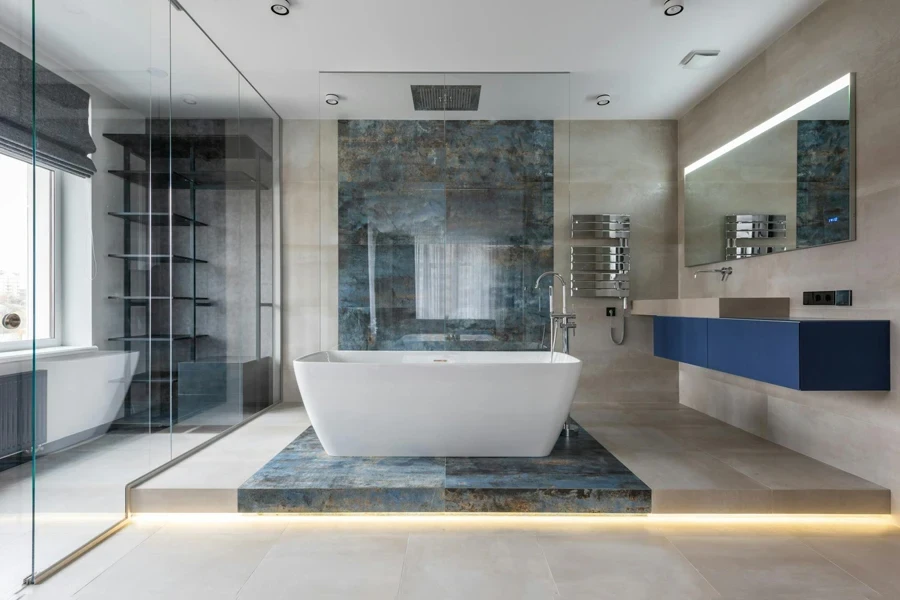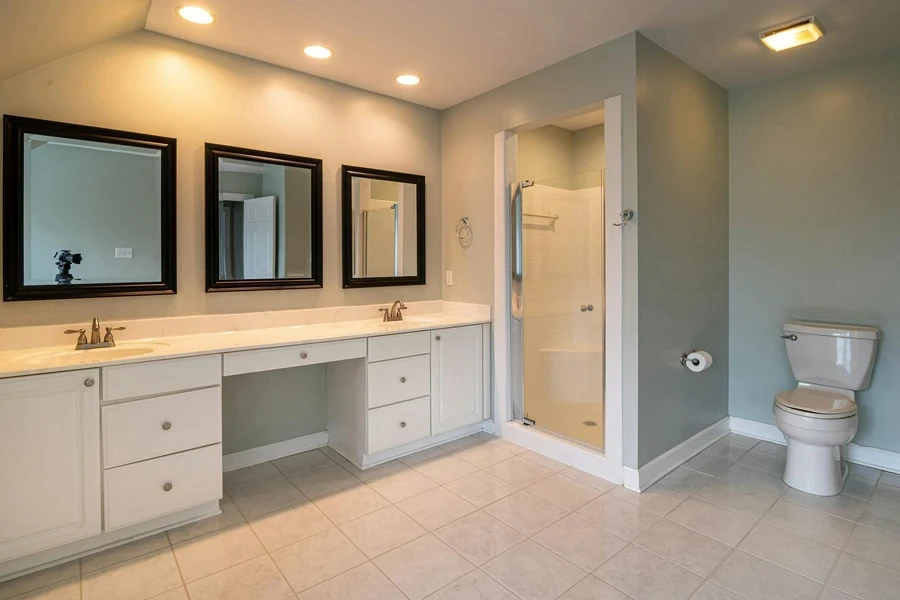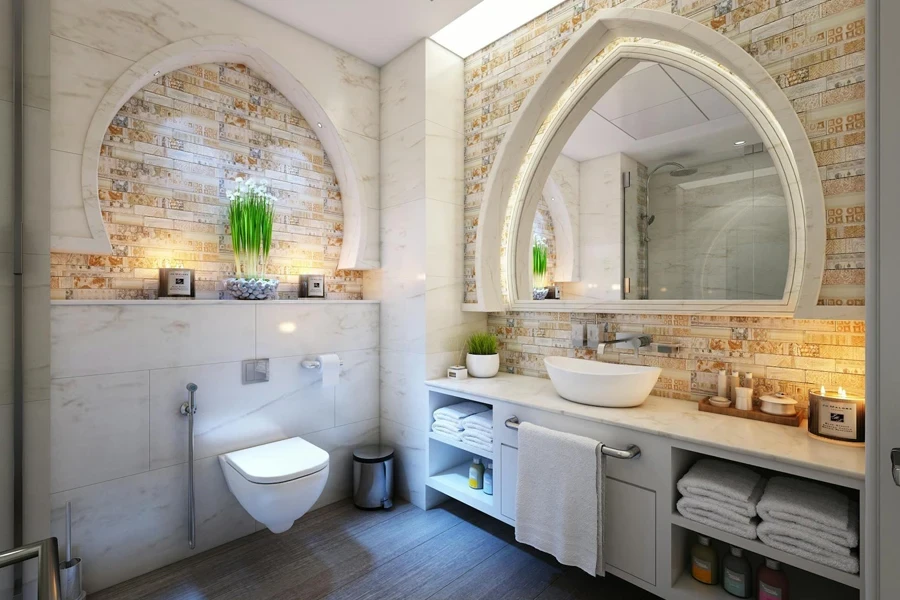Table of Contents
● Introduction
● Market overview
● Things to consider when selecting products
● Some types of bathroom products and their features
● Conclusion
Introduction
In the current bathroom design landscape, selecting the right products is essential for achieving a balance between visual appeal and functionality. High-quality bathroom accessories and fixtures play a crucial role in enhancing the user experience, embodying comfort and luxury. This guide aims to discuss how to choose the most suitable bathroom products, highlighting the need for a blend of style, practicality, and innovation to meet the modern market’s evolving preferences. It will provide insights to help professionals make choices that fulfill both the aesthetic and functional requirements of contemporary bathroom spaces, addressing the demands of today’s consumers and emphasizing the importance of eco-friendly design advancements.

Market overview
The bathroom products market, valued at $109.53 billion in 2023, is projected to reach $122.26 billion by 2024, growing at a CAGR of 11.6%, according to Global Bathroom Insights. This growth is driven by urbanization, changing lifestyles, and increasing demand for luxurious, functional bathroom spaces. The shift towards creating personalized retreats within homes is pushing the market towards innovative, high-quality solutions. This trend is indicative of broader socio-economic shifts towards customization and sophistication in living spaces. The market’s rapid response to these evolving preferences points to a future of continued expansion and enhanced product offerings, highlighting the industry’s capacity for innovation and adaptability.
Projected to reach $189.37 billion by 2028, the bathroom products market is thriving, fueled by the integration of smart technology. This growth reflects a rising demand for smart home capabilities that enhance convenience, efficiency, and personalization in bathroom settings. Innovations like intelligent toilets and digital faucets are leading this shift, underscoring a broader trend of technology blending into everyday life and making bathrooms luxurious yet functional spaces. This evolution in consumer preferences towards smart, sustainable bathroom solutions highlights a significant move towards eco-friendly living, with technologies that save water and energy, redefining bathrooms as central to the eco-conscious, tech-savvy home.

Things to consider when selecting products
Material durability and space efficiency
Selecting the ideal materials for bathroom fixtures is pivotal for balancing durability with style. Ceramic, celebrated for its hardiness and sleek finish, is a go-to for basins and toilets, resisting stains and microbes, ensuring a hygienic surface that’s easy to clean. Stainless steel, with its inherent strength and modern appeal, resists corrosion and wear, making it a durable choice for taps and towel bars, and its recyclability aligns with eco-friendly design principles. High-quality plastics, known for their versatility and resistance to fading and impact, are utilized in shower units and bath accessories, enabling a wide palette of colors and designs to suit any decor theme. These choices are not just about enduring utility; they’re about crafting spaces that reflect personal style and stand up to the rigors of daily use, ensuring that each bathroom component contributes to a cohesive and inviting environment that lasts.
Maintenance and optimized longevity
Selecting bathroom products with ease of maintenance at the forefront ensures that the bathroom remains an effortlessly inviting space. Materials like glazed ceramic and sealed granite are chosen for their ability to repel water spots and soap scum, simplifying cleaning routines. Similarly, quartz countertops offer durability and non-porous surfaces that require minimal upkeep, resisting stains and bacteria without the need for frequent sealing. Advanced surface treatments on faucets and shower doors repel water and fingerprints, making them easier to clean and maintain their shine over time. Tiles with stain-resistant grout options further reduce cleaning hassle, keeping the bathroom looking pristine with less effort. This focus on selecting materials and finishes that minimize maintenance demands underscores a practical approach to bathroom design, ensuring longevity and sustained appeal of the bathroom environment while optimizing the user’s convenience and time.
Technological integration
The adoption of smart technology in bathroom fixtures represents a leap forward in home automation, emphasizing user-centric design. Features like intelligent toilets equipped with motion sensors for hands-free lid operation, temperature-controlled seats for added comfort, and adjustable bidet settings for personalized hygiene underscore the shift towards bespoke functionality. Digital shower systems, which offer the ability to preset water temperature and flow rates with precision, now also integrate with home automation systems for voice or app control, making the shower experience seamlessly customizable. These technological enhancements not only serve the basic needs of hygiene but are meticulously designed to adapt to and anticipate the user’s preferences, turning the bathroom into a highly personalized haven.
Holistic well-being and lighting
The future of bathroom lighting focuses on functionality and personal well-being, with contemporary trends highlighting the adoption of dimmable LEDs and chromotherapy features. Dimmable LED lights offer versatility in adjusting brightness levels, essential for activities ranging from grooming to relaxing, while significantly reducing energy consumption. Chromotherapy lighting, incorporating various colors, plays a therapeutic role by influencing mood and promoting mental wellness based on the principles of color therapy. Together, these advanced lighting solutions are transforming bathrooms into personalized spaces that support both task-oriented activities and relaxation, aligning with a growing emphasis on sustainability and personal health in home design.
Some types of bathroom products and their features
In the evolving landscape of bathroom design, a select group of products stands out for seamlessly combining functionality, comfort, and aesthetic appeal. These essentials not only boost the bathroom’s utility but also elevate it to a haven of well-being and style.
Toilets
Central to bathroom innovation, modern toilets have enhanced the fundamentals of personal hygiene with features such as efficient flushing systems and eco-friendly designs. Moving beyond mere convenience, these toilets are designed with water-saving capabilities, reflecting a commitment to environmental sustainability. The focus on improved hygiene and water conservation aligns with the growing trend towards eco-conscious living, making the humble toilet a cornerstone of the modern bathroom.
LED mirrors
LED mirrors have revolutionized their traditional role, emerging as a focal point of contemporary bathroom aesthetics. Providing optimal lighting for grooming, these mirrors blend functionality with modern elegance. Innovations like anti-fogging, touchless controls, and adjustable brightness not only make LED mirrors a practical choice but also a testament to the sleek design. Their role is pivotal in modern bathrooms, marrying aesthetic appeal with daily utility.

Shower heads
Shower heads are a pivotal element in modern bathrooms, significantly enhancing the showering experience with a variety of spray patterns and intensities. From gentle mists to powerful jets, they offer customizable settings to suit individual preferences, ensuring every shower is a personalized experience. The inclusion of a versatile shower head can transform the bathroom into a versatile space for relaxation and rejuvenation. Whether it’s starting the day with a refreshing spray or unwinding in the evening with a soft, relaxing flow, the right shower head makes all the difference, marking it as a fundamental component for any modern bathroom setup.
Towel racks
Towel racks, a fundamental bathroom accessory, offer practical benefits beyond their basic function. By ensuring towels are neatly organized, and within reach, they contribute to a tidy, moisture-free bathroom environment. Their presence can significantly enhance the bathroom’s functionality and comfort, making them a staple in bathroom design.
Non-slip bath mats
Non-slip bath mats are essential for ensuring safety and adding comfort underfoot in any bathroom setting. Designed to prevent slips and falls on wet surfaces, these mats are crucial for households of all ages. Beyond safety, non-slip bath mats come in various materials, colors, and designs, allowing them to serve as both a functional item and an element of decor. They are easy to clean and maintain, making them an ideal choice for enhancing bathroom safety without sacrificing style.
These foundational products collectively redefine the modern bathroom, contributing distinct features and benefits that extend beyond basic functionality. Integrating these elements, homeowners and designers can craft a bathroom space that not only meets practical demands but also promotes personal well-being, relaxation, and sophisticated style.
Conclusion
Choosing the right bathroom products is an intricate process that transcends aesthetics to embrace functionality, durability, and sustainability. This holistic approach blends style, quality, and eco-consciousness with the latest technological advancements, addressing the evolving needs of consumers. It transforms bathrooms from basic utility spaces to havens of comfort and sustainability, ensuring products not only meet current demands but are also future-ready. This method fosters a connection with eco-friendly and technologically advanced products, enhancing both the user experience and environmental health. It advocates for informed, forward-thinking design, establishing modern bathrooms as spaces that prioritize well-being and ecological responsibility.



